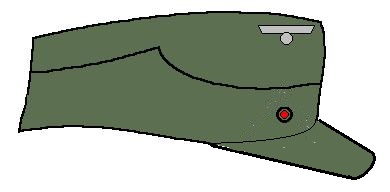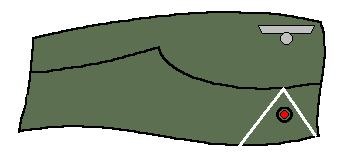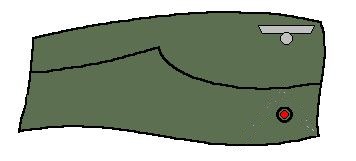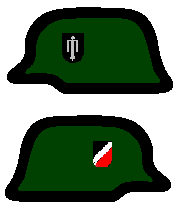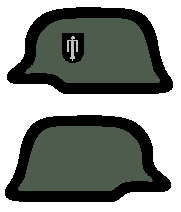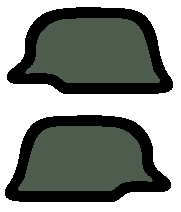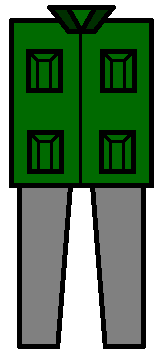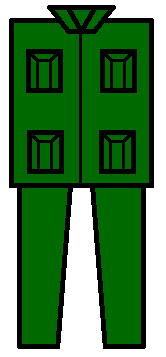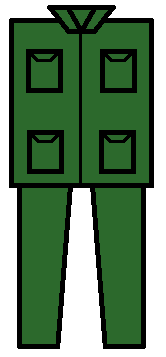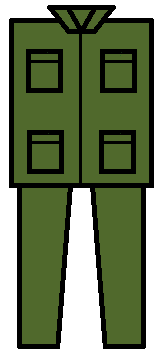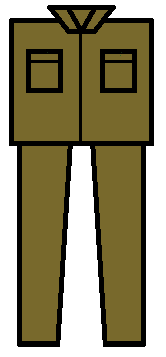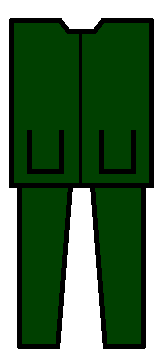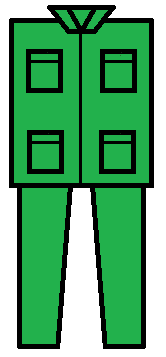| 1.
Tunic and trousers
The German
army had a large variety of types of tunics and these all differed
somewhat during the war. The best known is the Feldbluse, which was
worn in combat. For a modeler it can be important to tell the variations
apart, so that – for instance – you do not put a figure
with a uniform that appeared only in 1943 in a "battle of France"
diorama.
1.1. Feldbluse and trousers
This
is the tunic that most troops would wear on combat duties.
- 1936
The Feldgrau (FG) Feldbluse first appeared in 1936 (M1936) and
at that time it had 5 buttons, 4 pleated pockets
with pointed flaps and a Dark Blue Green (DBG
– a deep green color; there was little blue about it) collar
and sholder straps. It was worn with stone gray trousers
- 1940
The first variation appeared in May 1940 when the DBG
collar and shoulder straps were changed to FG.
Higher ranks tended to retain the DBG version. The FG collared
version was not in widespread use until 1941-42. (Note that Waffen-SS
troops never had the DBG collar in the first place.)
At the same time the trousers were changed to FG.
- 1941
In May 1941 the number of buttons was increased to 6 (if you really
want to pay attention to this).
- 1942
In 1942 the pockets lost their pleats. This only
became common sight in 1943.
- 1943
In 1943 the flaps of the pockets were made straight.
From this time on the tunic was often worn with the collar open.
- 1944
In September 1944 a new model appeared, that
I have not seen often on figures. It was a lot shorter, had 6
buttons and only 2 plain breast pockets. By that time the FG was
a lot browner as well. This uniform was only to be worn with ankle
boots. Apart from Panzer Lehr, which received it in the
Summer of 1944, other troops only received it at war's end, with
newly formed units issued first.
Remarks
-
As the German authorities allowed older items
to be worn after a model was changed, you have some liberty.
The pleated pockets, for instance, could still be seen in
1943.
-
Normally the pre-1944 models were worn with the collar
closed, although many pictures show the troops with
open collars during long marches. From December 1943, staff
Officers and Generals could officially wear their tunic with
open collars to show their decorations (e.g. Ritterkreuz).
Although, as the war progressed, it could be seen more often
with the collar open.
-
The breast eagle was aluminum thread on a
DBG background (the latter is not visible in these scales),
except for generals where it was golden (or yellow from 1938
onwards).
-
An officer’s
tunic would be slightly different from the other
ranks tunic. Most noticeable might be the turned back cuffs.
- The
tunic could be worn over a multitude of shirts in subdued
colors (FG, green, gray, …).
-
During the course of the war the FG color varied a
lot, the trend being from green towards browner shades.
The M1944 uniform was close to British kaki.
-
While most troops wore the tunic over plain trousers, mounted
troops wore breeches (in stone gray or FG,
according to the period), with leather reinforcements. Officers
were allowed to wear riding breeches (more often than not
without the reinforcements). Some senior NCO’s wore
them too. Staff officers wore a triple crimson stripe (wide-narrow-wide)
on the sides of their riding breeches. Generals had similar
stripes but in bright red.
1.2.
Rock, Ausgehrock, Waffenrock and matching trousers
These
were for the more sociable occasions, and are perhaps of less interest
to the modeler. We won't go into too much detail.
If you ever come across a figure wearing them, the Rock
and Ausgehrock could best be identified by having
hidden lower pockets (only the flap being visible), turned back
cuffs (for all ranks) and pleated top pockets.
The
Waffenrock (used for ceremonies) had no pockets
on the front, only two false ones at the back. The turned back cuffs
with Doppellitze were DBG. It was often worn without a belt.
What is important, is that it was abolished after March 1940. In
some cases it was either modified to a Rock or to a Feldjacke and
would, in this guise, be worn by officers close to the front line.
Sometimes it retained part of the original piping (especially at
the front closure). The higher the rank, the more piping tended
to be retained.
The
trousers for these uniforms would be stone gray and have piping
at the sides in Waffenfarbe, and could be either straight or riding
breeches.
1.3. Fatigue uniform (Drillichrock)
The
fatigue uniform only existed for men below the rank of officer.
It only had 2 hip pockets without flaps and no
collar or shoulder insignia. It was worn unbuttoned at the throat
and used with the black belt.
At first it was a cream/off white color. In February
1940 a dark green version appeared, which
was used as a makeshift summer uniform in 1941 -
vide infra.
In 1942 a completely new reed or dark green
version appeared. It was cut like the Feldbluse and followed its
variations. The best way to tell it apart from a regular Feldbluse
is by the wrinkling; the fabric was much lighter and thus wrinkled
more easily.
1.4. Summer tunic
While
in the summer of 1941 the green fatigue uniform
was already worn as a makeshift summer tunic, a true summer tunic
was introduced in 1942 (but only became widespread
in 1943), and was basically the same reed green fatigue uniform
with rank insignia. It became common in the summer of 1943 when
reed green trousers also became available. This item resembles the
1942 or 1943 field tunic a lot. (I am unsure if
it was ever issued with pointed pocket flaps).
Incidentally, this reed green was about the same shade as the very
early FG, although a bit paler. It could also be seen in light gray
(although rarely).
1.5.
Winter dress
The
first expedient solution for winter camouflage were blankets cut
to size, or the cream/off white fatigue uniform. Some standardization
occurred towards a calf or waist length M1942 thin white cotton
snow shirt with matching trousers or a three-quarter length thin
white coverall.
Apparently,
in 1942 a reversible white / Zeltbahn splinter
pattern collarless smock appeared. It had a chord at the chest,
much like the earlier Waffen SS smocks. Matching overtrousers existed.
(I must admit I have not seen them in pictures yet.)
In the autumn of 1942 the M1942 white/FG (or mouse
gray) reversible padded winter overcoat was introduced,
which existed in a quilted version. It was quite high in length
and had a hood. Some had a Zeltbahn camouflage pattern on the inside
instead of the FG and some were non-reversible. The only insignia
worn on this dress was the colored sleeve band, which could be red
or black, on the left or right upper arm, or both, depending on
regulations. The purpose of this band was to be able to tell German
troops from their Russian adversaries, who also would be wearing
white camouflage.
A M1938 or M1942 mountain troop snow uniform also existed, which
was available in limited quantities for regular troops. It was reversible
in white and FG, and was recognizable by its 3 breast pockets.
Matching
trousers existed for the above.
The
higher ranks also wore ankle length sheepskin overcoats. Some standard
greatcoats were lined with sheepskin.
1.6. Camouflage dress
(Some
of this equipment is already mentioned under "winter dress".)
In
the later stages of the war, camouflaged equipment became more and
more available, although some already existed by cutting Zeltbahn
(ZB) tent quarters to size, or wearing it as a poncho. This ZB has
a dark and lighter side.
Some of the padded reversible M1942 winter tunics
had a ZB pattern on the inside, and some existed in the same cut,
but non-reversible in ZB splinter or blotch pattern.
In 1943 a new smock appeared in
splinter or blotch pattern (1944) which was non reversible.
In 1944 a sleeveless apron in
ZB splinter (Splittermuster) or soft blotch pattern (aka Marsh pattern
or Sumpfmuster) appeared.
Occasionally Italian or Waffen SS camouflage items were worn.
Matching
trousers existed for the above, although used less often.
2.
Headgear
2.1.
Schirmmütze
The
peaked cap (Schirmmütze) was FG with a black peak, and was
piped in the Waffenfarbe (WF) as shown on the left for an artillery
officer (cf. A). The central band was DBG, piped in WF. For generals
the piping was gold (figure on the right).
Note that at the start of the war, even for generals, the eagle
on the cap was aluminum, although some ignored this rule and replaced
it with a golden version. The latter became official only in January
1943.
Chin straps (cf. B) were worn, these were black for ranks below
officer (almost invisible in small scale), aluminum for officers
and gold for generals.
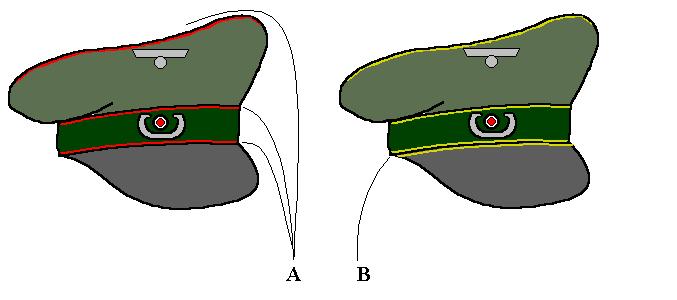
While normally associated with the walking out uniform, officers
tended to retain the peaked field cap, even at the front line. Even
though this cap was to be replaced by the Feldmütze in January
1941 and abolished in April 1942, it never became rare. Most modelers
of my generations have grown up believing that all German officers
always wore this type of headgear and were always shooting with
their Luger.
An older version (M1934) of this cap existed, which, confusingly,
was called ‘Feldmütze alter Art’. it could
perhaps best be described as a ‘soft Schirmmütze’,
i.e. without the stiffened crown. It had no chinstrap. In the field,
many officers and NCO modified their Schirmmütze to resemble
this one, by removing the stiffening at the crown.
2.2.
Stahlhelm
On
the frontline the helmet was of course something very useful. Its
design changed during the war, but not to such an extent that it
is visible in small scale. At the beginning of the war it was painted
glossy dark green with a decal on the right in the national colors
and an eagle on the left. (See poor drawings below. Yes, I know,
you need some imagination, but hey, in 1/72 you won’t tell
the difference anyway, and as such you are sure I am not infringing
any copyrights.) At the start of the war many troops covered the
helmet with mud to eliminate the sheen, or just covered the decals.
In March 1940 the helmets appeared in matt slate/dark
gray and in March 1940 the right decal was eliminated.
The eagle decal also disappeared at the
end of August 1943.
Helmet covers in ZB pattern became more frequent as the war progressed.
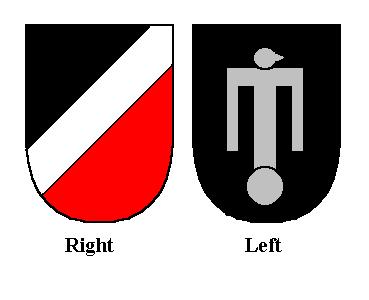
2.3. Feldmütze
When
there was less risk, a field cap without peak could be worn (Feldmütze).
It existed in different versions (M1934,M1935,M1938,M1942), that
in small scale all look similar (the M1942, for instance, had 2
buttons at the front).
It was made in FG cloth and was piped in aluminum for officers,
or gold (yellow) for generals (drawing on the right). A chevron
in WF was present at the front. Again the eagle was aluminum, even
for generals until January 1943. The chevron was
to be removed in July 1942 (with the appearance
of the M1942 sidecap), but it could be seen afterwards.
The M1942 variant of this field cap appeared with foldable flaps
that could be drawn over the ears and had 2 buttons at the front.
It also existed in black for panzer
crews.

2.4.
Einheitsfeldmütze
In
June 1943 a new M1943 peaked field cap (Einheitsfeldmütze)
was introduced, based on the Bergmütze of the mountain troops.
The major difference with respect to the latter is a longer peak.
(The tropical version had an even longer peak.)
It was basically the M1935 field cap, with a peak added. The color
was FG.
Piping would be applied at the crown for officers and generals,
as for the previous model.
It also existed in black for panzer crews.
2.5. Other headgear
In the winter, privately purchased fur (lined) cap could
be found in brown, black or gray. Another common sight was a FG
toque.
"Artistic" overview
|
| |
1936-39 |
1940 |
1941 |
1942 |
1943 |
1944-45 |
| |
|
|
|
|
|
|
| |
|
|
|
|
|
|
| |
|
|
|
|
|
|
| Regular |
|
|
|
|
|
|
| Summer |
|
|
|
|
|
|
| |
Jackboot |
Jackboot |
Jackboot |
Jackboot |
Jackboot |
Jackboot |
| |
|
|
(Low
boots with gaiters) |
(Low
boots with gaiters) |
Low
boots with gaiters |
Low
boots with gaiters |
3. Boots and shoes
The high
boots were black. Those of officers wearing riding breeches were a
bit higher.
From November 1939 all boots were shortened by 5 cm (0.7 mm in 1/72).
Normally the trousers were tucked into these boots, although as the
war progressed this tended to change.
In the winter of 1940-1941 ankle boots with gaiters
(in FG or greenish brown) were gradually introduced, and were common
from 1943 onwards. The shoes were black, although at the very end
of the war brown shoes could be found as well. The gaiters were not
always worn.
Mountain
troops had ankle boots from the outset with FG bandages to cover the
lower legs.
Winter
boots existed of a heavier cut with a felt covered shaft.
4. Greatcoat
A typical
German garment was the greatcoat. It was made in FG with a
DBG collar and had turned back cuffs. The collars didn't
carry any Litzen or other insignia (in contrast with Waffen SS greatcoats
that carried SS Runen and rank insignia on the lapels between October
1940 and June 1942 - some sources claim until February 1943).
For
guard duties a slightly different version existed with 4 instead of
2 pockets. It had a hood and no turn back cuffs like the standard
greatcoat.
Lapels
on a general’s greatcoat were normally in red. Higher ranking
officers sometimes wore leather versions of the greatcoat, which,
for generals, did not have the red lapels.
The general’s greatcoat also had a "half belt" and
a central rear vent hidden by a pleat at the rear.
The DBG
collar was to be replaced with a FG collar from May 1940 onwards,
although this was widely ignored.
In 1942/43 a new design was introduced with a wider
collar. This version was not seen with the DBG collar.
A rubberized
greatcoat existed for motorcycle troops. It was quite popular with
other troops as well. It had one large round thigh pocket
on the left.
Some
greatcoats were modified with fur lining.
5.
Belt
In general,
the belt was black with an aluminum or gray buckle (hard to distinguish
in 1/72). Early in the war officers were often seen with a dark brown
leather belt with an open aluminum claw (gold for generals). Up until
the Polish campaign the latter could be worn with an optional diagonal
"suspender" strap.
When
fully equipped the belt also had shoulder straps, which converged
in a "Y"-shape at the back. These were rather rare up until
the end of the French campaign.
6.
Breast eagle
The breast
eagle started the war in silver gray or aluminum (gold or yellow for
generals), but this was changed to mouse gray in June 1940. Depending
on the frequency an individual saw combat, the earlier version was
sometimes retained.
In principle it was only worn on the Feldjacke, i.e. not on greatcoats,
padded winter clothing, camo smocks, fatigue uniforms, etc. but sometimes
troops added them regardless, an example in case being the use of
the fatigue uniform as a summer tunic.
7.
Shoulder insignia
On most
types of uniform, rank was indicated on the shoulders. Officers
had stiffer "boards" (not nearly the size of their Russian
equivalents however), and the other ranks had simpler straps. Apart
from the design that indicated the rank, it was in DBG
with WF piping at the start of the war. It changed to FG in
May 1940, but the DBG versions were widely used thereafter.
Rank insignia on camouflaged
tunics were worn on the upper arm (if any), and
are of a completely different type. Why the Germans developed a completely
different type of rank insignia is a mystery to me. (The Waffen SS
used the same insignia on their camouflaged tunics, but had yet another
type of ranking system for their regular tunics...)
Disclaimer:
I am sure this article can be vastly improved upon, so I would invite
anyone with superior knowledge to contact
me.
|



